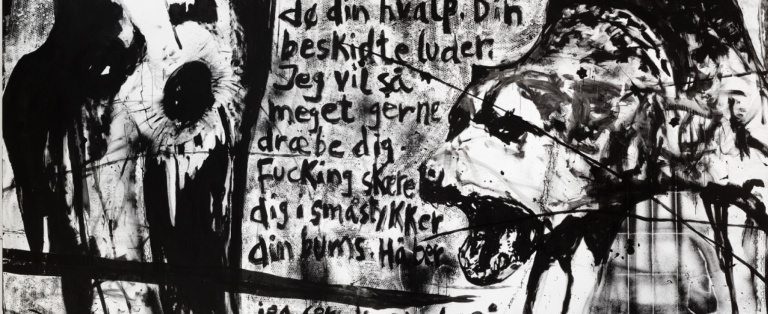Becoming Animal
Foredrag med Claus Carstensen i Media Auditoriet
Onsdag den 18. januar kl. 13
Claus Carstensen holder foredrag om udstillingsprojektet Becoming Animal.
Becoming Animal
“As for humans, God tests them so that they may see that they are like the animals. Surely the fate of human beings is like that of the animals; the same fate awaits them both: As one dies, so dies the other. All have the same breath; humans have no advantage over animals. Everything is meaningless.”
Ecclesiastes Chapter 3, Verses 18-19
Motto
Der reaktionäre Versuch, technisch bedingte Formen, das heißt abhängige Variable zu Konstanten zu machen, tritt ähnlich wie im Jugendstil im Futurismus auf. Walter Benjamin, Zentralpark
The exhibition Becoming Animal embraces the most existential issues of art of the from the 19th to 21st centuries: what it means to be human, and how this is explored in art. Unlike animals, who have no consciousness of their own existence and the fact that their lives will end, humans are painfully conscious of themselves, the limits of life, and the emptiness that lies ahead.
The works selected for the exhibition all process this painful consciousness and represent a broad section of the major artworks from the past to our time. The exhibition is a collaboration between Den Frie Centre of Contemporary Art and the Museum of Religious Art and will run from spring to autumn 2018.
Becoming Animal is a vital contribution to the investigation of the existential dimensions of art from the 19th to 21st centuries.
Participating artists
Carl Andre, Zven Balslev, Hans Bellmer, Tim Berresheim, Ditlev Blunck, Aroldo Bonzagni, Thomas Bruun, Werner Büttner, Claus Carstensen, Ursula Reuter Christiansen, Gardar Eide Einarsson, James Ensor, Matias Faldbakken, Isa Genzken, Francisco de Goya, Jan Grarup, David Griggs, Vilhelm Hansen, John Heartfield, C.F. Hill, Andreas Hofer, Johannes Holbek, Victor Hugo, Niels Hansen Jacobsen, Annnette Kjær Jensen, Asger Jorn, Sam Kiyomarsi, Theodor Kittelsen, Max Klinger, Jutta Koether, P.S. Krøyer, Alfred Kubin, Romeo Lee, Peter Louis-Jensen, Jens Lund, Gabriel von Max, Bjarne Melgaard, Mauel Ocampo, Albert Oehlen, Storm P, Pier Paolo Pasolini, Steven Parrino, Odilon Redon, Martin Schongauer, Jeffrey Silverthorne, Eik Skaløe, Rudolf Stingel, Christian Vind, Herbert Volkmann, J.F. Willumsen and Thomas Zipp.
Dark Minimalism and Symbolism
In the exhibition, the curator juxtaposes symbolism and minimalism, art movements that with their own artistic languages shaped the 19th and 20th centuries’ exploration of the relationship between life and death, emptiness and meaning. Empty transcendence is confronted by a series of apparently irreconcilable and artistically/politically divergent movements that share the goal of trying to substitute empty transcendence with concepts of eternity and utopia.
The exhibition is conceptual in the sense that it draws on a literary and philosophical framework to address the development of consciousness, self-awareness and ‘consciousness raising’. The primary fererences in this context are Friedrich Nietzsches writings and ‘Becoming-intense, Becoming-Animal, Becoming-Imperceptible’ – section 1730 of Gilles Deleuze and Félix Guattari’s A Thousand Plateaus: Capitalism and Schizophrenia (Continuum, London 1987 [1980]) – and Giorgio Agamben’s The Open: Man and Animal (Stanford University Press, 2004 [2002]).
The exhibition is curated by the Danish artist Claus Carstensen, and brings together works from throughout Scandinavia, Europe and the US alongside Claus Carstensen’s own extensive collection of art.
The exhibition is accompanied by a richly illustrated, research-based book published by Black Dog Publishing, including peer-reviewed essays on emptiness and transcendence in art. Contributions by Ron Broglio, Donald Preziosi, Raymond Tallis, Sven-Olov Wallenstein, Claus Carstensen, Anne Gregersen, and Jens Tang Kristensen.
